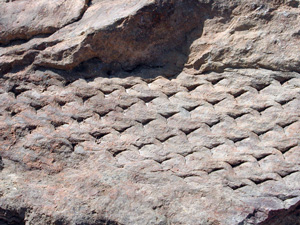Resource Library
Plant of the Week: Moss, Giant Club
The University of Arkansas System Division of Agriculture does not promote, support or recommend plants featured in "Plant of the Week." Please consult your local Extension office for plants suitable for your region.
Plant of the Week
Giant Club Moss
Latin: Lepidodendron sp.

As a nature lover, I find all manner of life interesting, even long-dead life. Fossils are especially intriguing finds, and like most Arkansans I’ve picked up a fair number of crinoids stems and other sea creatures from the periods when most of the state was submerged in shallow ancient oceans. Occasionally, especially in the Ozark highlands, deer hunters are lucky enough to stumble across a plant fossil from the Carboniferous period about 300 to 350 million years ago.
One of the most common trees of the Carboniferous period was the giant Lepidodendron (literally translated as scale tree but also called giant club moss), which grew in the hot, shallow swamps of the time. These trees grew to 120 feet tall, with trunks as much as three feet through. It is believed that they grew very fast and close together, like so many telephone poles, until they reached maturity, at which time the stem branched at the top of the long stem and spore production occurred. Some speculate that the lifespan of individual trees was only 15 years and that trees died when spore production occurred.
As the unbranched portion of the stem grew, it produced long, grass-like leaves that were attached to the trunks in spiral whorls. These leaves, high in lignin, detached at the half to inch-long, diamond-shaped leaf scar on the main stem. These leaves, along with the stems of the Lepidodendrons and ancient ferns and horsetails, are a major constituent of coal deposits found throughout the world. The trunks, when they fell in an area where fossil formation occurred, left behind an imprint that some describe as looking like fossilized alligator skin, while others say it looks like a fossilized car track in the rock.
The Carboniferous, a period often subdivided by American geologists into the Mississippian and Pennsylvanian periods, was a time when ancient sea levels were low, presumably due to large accumulations of ice at the poles. Continental collisions were also occurring during this period when the combined landmass of South America and Africa – joined together, the landmass was called Gondwana – collided with Euramerica, the landmass containing Europe and North America. The Ouachita Mountains formed during this period, and the Ozarks were lifted out of the sea.
At the time, Arkansas was situated near the equator, and conditions were hot and steamy. During the beginning of the Carboniferous period, carbon dioxide levels were probably very high by modern standards, but as the land plants became more successful, the concentration decreased. Cooling of the climate and depletion of the high carbon dioxide probably were major contributors to the biological collapse and extinctions that occurred at the close of the Carboniferous.
Fossilized Lepidodendron specimens can be found throughout the world. In Arkansas, Lepidodendron fossils are found in the Ozarks because the rest of the state was below the sea or being uplifted into high mountains when they had their reign on earth. Though the giant forms of these trees disappeared with the environmental collapse, they remain with us as small herbaceous plants called Lycopodiums. Lycopods are found in the eastern states but do not extend into Arkansas. Though often listed as fern relatives, they are in fact more ancient than ferns.
By: Gerald Klingaman, retired
Retired Extension Horticulturist - Ornamentals
Extension News - September 30, 2011
The University of Arkansas System Division of Agriculture does not maintain lists of retail outlets where these plants can be purchased. Please check your local nursery or other retail outlets to ask about the availability of these plants for your growing area.